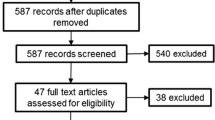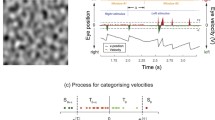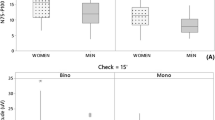Abstract
Purpose
To define the normal ranges for the slow oscillations (SO) and fast oscillations (FO) of the electro-oculogram (EOG) recorded to International Society for Clinical Electrophysiology of Vision (ISCEV) standards. The effects of age and gender on the EOG ranges were examined.
Methods
ISCEV standard SOs and FOs were recorded from 121 subjects (51 % male) aged from 7 to 72 years. Study variables for the SO were dark trough (DT) and light peak (LP) amplitudes (µV), times to DT and LP (min), and the Arden ratio (LP/DT amplitude). The FO was fit by a sine wave and peak-to-peak amplitude (µV), phase (°), and peak-to-trough (PT) ratios derived. The effects of age, gender and pupil size on EOG parameters were examined by multiple regression analysis.
Results
The average Arden ratio was 2.5. Arden ratio decreased with age at a rate of 0.13 per decade of age (R 2 = 0.14, P < 0.0001). The 5th percentile of the Arden ratio decreased from 2.0 to 1.7 between 10 and 60 years of age. Median time to LP was 9 min (interquartile range 8–9 min). Time to LP was age-dependent and increased by 2 min for subjects over 55 years of age compared with those less than 25 years. EOG amplitudes were greater in women than in men (P < 0.005). The average PT ratio was 1.18, which was not affected by age or gender. Time to reach the light trough of the FO was 40 s, which increased with age (1.1 s/decade). No correlation was observed between Arden ratio and PT ratio.
Conclusions
The major strength of this study is the definition of the normal range and associated lower limits of ISCEV standard EOGs based on recordings from 121 subjects balanced by gender and spanning the 1st through 8th decades of life. Decreased Arden ratio and increased time to LP are associated with aging, which is likely due to the intricate mechanisms involved in generation of the light rise. Differences between the FO and SO with respect to the effects of aging are consistent with separate generation of these two EOG signals.




Similar content being viewed by others
References
Arden GB, Constable PA (2006) The electro-oculogram. Prog Retin Eye Res 25(2):207–248. doi:10.1016/j.preteyeres.2005.11.001
Wu J, Peachey NS, Marmorstein AD (2004) Light-evoked responses of the mouse retinal pigment epithelium. J Neurophysiol 91(3):1134–1142. doi:10.1152/jn.00958.2003
MacDonald IM, Lee T (2013) Best vitelliform macular dystrophy. In: Pagon RA, Adam MP, Ardinger HH et al. (eds) GeneReviews® [Internet]. University of Washington, Seattle. http://www.ncbi.nlm.nih.gov/books/NBK1167/
Marmor MF, Brigell MG, McCulloch DL, Westall CA, Bach M, International Society for Clinical Electrophysiology of V (2011) ISCEV standard for clinical electro-oculography (2010 update). Doc Ophthalmol 122(1):1–7. doi:10.1007/s10633-011-9259-0
Constable PA, Lawrenson JG, Arden GB (2006) Light and alcohol evoked electro-oculograms in cystic fibrosis. Doc Ophthalmol 113(2):133–143. doi:10.1007/s10633-006-9023-z
Weleber RG (1989) Fast and slow oscillations of the electro-oculogram in Best’s macular dystrophy and retinitis pigmentosa. Arch Ophthalmol 107(4):530. doi:10.1001/archopht.1989.01070010544028
Marmor MF, Zrenner E (1993) Standard for clinical electro-oculography. Doc Ophthalmol 85(2):115–124. doi:10.1007/bf01371127
Arden GB, Barrada A (1962) Analysis of the electro-oculograms of a series of normal subjects: role of the lens in the development of the standing potential. Br J Ophthalmol 46(8):468–482. doi:10.1136/bjo.46.8.468
Geijer-Mannerfelt T, Pallin O (1967) On the correlation between ERG and EOG in normal eyes. In: Advances in electrophysiology and pathology of the visual system: 6th ISCERG symposium
Reeser F, Weinstein GW, Feiock KB, Oser RS (1970) Electro-oculography as a test of retinal function—normal and supernormal EOG. Am J Ophthalmol 70(4):505–514
Adams A (1973) The normal electro-oculogram (E. O. G.). Acta Ophthalmol 51(4):551–561. doi:10.1111/j.1755-3768.1973.tb06034.x
Krogh E (1975) Normal values in clinical electrooculography. Acta Ophthalmol 53(4):563–575. doi:10.1111/j.1755-3768.1975.tb01775.x
Krogh E (1977) Normal values in clinical electrooculography IV. Analysis of two dimensionless EOG parameters and their relation to other variables. Acta Ophthalmol 55(5):739–749. doi:10.1111/j.1755-3768.1977.tb08272.x
De Rouck A, Kayembe D (1981) A clinical procedure for the simultaneous recording of fast and slow EOG oscillations. Int Ophthalmol 3(3):179–189. doi:10.1007/BF00130702
R: A Language and Environment for Statistical Computing (2014) R Foundation for Statistical Computing. http://www.R-project.org
Wickham H (2009) ggplot2: elegant graphics for data analysis. Springer, New York
Højsgaard S, Halekoh U, Yan J (2006) The R Package geepack for Generalized Estimating Equations. J Stat Softw 15(2):1–11
Yan J, Fine JP (2004) Estimating equations for association structures. Stat Med 23:859–880
Koenker R (2013) Quantreg: quantile regression. Encycl Environ 4. doi:10.1002/9780470057339.vnn091
Arden GB, Wolf JE (2003) Differential effects of light and alcohol on the electro-oculographic responses of patients with age-related macular disease. Invest Ophthalmol Vis Sci 44(7):3226–3232
Fryar CD, Gu Q, Ogden CL (2012) Anthropometric reference data for children and adults: United States, 2007–2010. Vital Health Stat Ser 11 Data Natl Health Surv 252:1–48
Nakao H, Miki N, Nagata M, Sasaki Y, Yamasaki A, Endo M, Setogawa A, Murata Y, Tamai A (1995) Fast oscillations of the electro-oculogram in a series of normal subjects. Jpn J Ophthalmol 39(2):113–119
Mergaerts F, Daems E, Van Malderen L, Spileers W (2001) Recording of the fast oscillations in the human electro-oculogram. Doc Ophthalmol 103(1):63–72. doi:10.1023/a:1017915132721
Bonilha VL (2008) Age and disease-related structural changes in the retinal pigment epithelium. Clin Ophthalmol 2(2):413–424
Curcio CA, Millican CL, Allen KA, Kalina RE (1993) Aging of the human photoreceptor mosaic: evidence for selective vulnerability of rods in central retina. Invest Ophthalmol Vis Sci 34(12):3278–3296
Delori FC, Goger DG, Dorey CK (2001) Age-related accumulation and spatial distribution of lipofuscin in RPE of normal subjects. Invest Ophthalmol Vis Sci 42(8):1855–1866
Panda-Jonas S, Jonas JB, Jakobczyk-Zmija M (1995) Retinal photoreceptor density decreases with age. Ophthalmology 102(12):1853–1859
Panda-Jonas S, Jonas JB, Jakobczyk-Zmija M (1996) Retinal pigment epithelial cell count, distribution, and correlations in normal human eyes. Am J Ophthalmol 121(2):181–189
Decuypere JP, Monaco G, Missiaen L, De Smedt H, Parys JB, Bultynck G (2011) IP(3) receptors, mitochondria, and Ca signaling: implications for aging. J Aging Res 2011:920178. doi:10.4061/2011/920178
Acknowledgments
The National Institutes of Health (NIH) Intramural Research Program provided financial support in the form of human Protocols 97-EI-0080 and 08-EI-N014. Alisa Thavikulwat was funded by the NIH Medical Research Scholars Program, a public–private partnership supported jointly by the NIH and generous contributions to the Foundation for the NIH from Pfizer Inc, The Doris Duke Charitable Foundation, The Newport Foundation, The American Association for Dental Research, The Howard Hughes Medical Institute, and the Colgate-Palmolive Company, as well as other private donors. The sponsors had no role in the design or conduct of this research.
Author information
Authors and Affiliations
Corresponding author
Ethics declarations
Conflict of interest
All authors certify that they have no affiliations with or involvement in any organization or entity with any financial interest (such as honoraria; educational grants; participation in speakers’ bureaus; membership, employment, consultancies, stock ownership, or other equity interest; and expert testimony or patent-licensing arrangements), or non-financial interest (such as personal or professional relationships, affiliations, knowledge or beliefs) in the subject matter or materials discussed in this manuscript.
Additional information
Rafael C. Caruso and Brett G. Jeffrey are equal senior authors.
Electronic supplementary material
Below is the link to the electronic supplementary material.
Appendices
Appendix 1
This appendix outlines the algorithm used by the UTAS E-2000 software (as detailed in the Manufacturer’s Operation Manual) for calculating average saccade amplitude during recording of the SO. For each 15-s interval: (1) A 5-point median filter was applied to the waveform to eliminate spike artefacts. With the median filter, a group of 5 points centered on the point in question were sorted and the value of the point in question replaced by the middle value in the group; (2) the peak to trough amplitude was found for each saccade using the following algorithm. A local maximum (minimum) was defined as a point that was higher (lower) than its 24 nearest neighbors (12 on either side) and that exceeds a predefined threshold. Saccade amplitude was determined from the difference between the maximum and minimum amplitudes; (3) Saccade amplitudes for a 15 s sweep were sorted and the largest and smallest amplitudes discarded; (4) the average saccade for each 15 s sweep was calculated from the remaining values.
Appendix 2
This appendix details the analysis performed by the UTAS E-2000 software (as detailed in the Manufacturer’s Operation Manual) for deriving FO parameters from the fit of a sine wave to the absolute amplitude data recorded during the FO protocol.
The amplitude of the sine and cosine components of the FO was determined using a discrete Fourier transform:
where N = total number of samples, T is the time for a full saccade, \(X_{N}\) is the amplitude of the FO at time nT and f is the frequency of the FO. For our FO recording conditions, N = 450 points, T = 2 s for a full saccade and f = 0.00666 Hz
Peak to trough amplitude (µV), of the sine wave was estimated from:
The mean amplitude of the standing FO was estimated as
The results from Eqs. 2 and 3 are used to calculate the peak-to-trough ratio:
The phase of the sine wave (\(\theta\), deg) measured relative to the time the light turns on in the light phase is estimated from:
Rights and permissions
About this article
Cite this article
Thavikulwat, A.T., Lopez, P., Caruso, R.C. et al. The effects of gender and age on the range of the normal human electro-oculogram. Doc Ophthalmol 131, 177–188 (2015). https://doi.org/10.1007/s10633-015-9514-x
Received:
Accepted:
Published:
Issue Date:
DOI: https://doi.org/10.1007/s10633-015-9514-x




